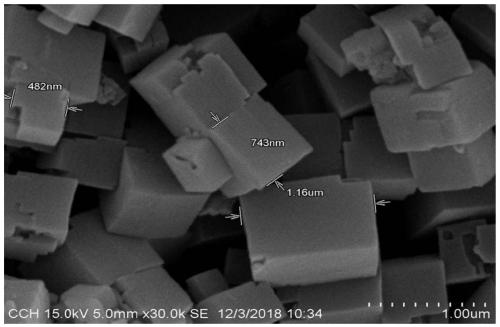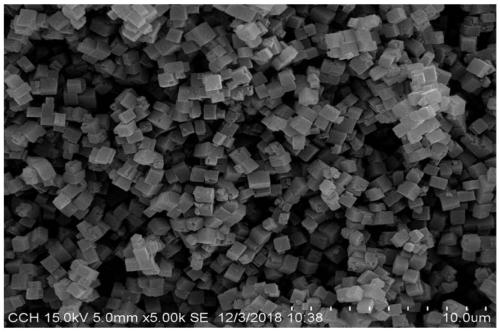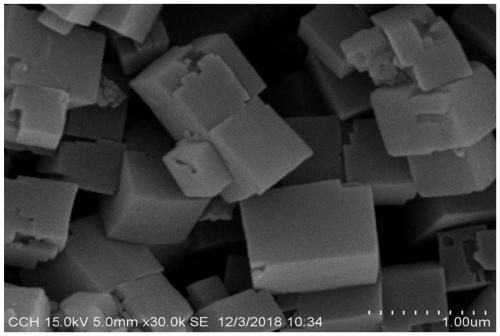Preparation method of catalyst for ammoxidation of caprolactam
A caprolactam and catalyst technology, applied in the direction of catalyst activation/preparation, preparation of organic compounds, physical/chemical process catalysts, etc., can solve the problems of low conversion rate, low reaction temperature, low selectivity, etc., and achieve low cost and simple preparation , Preparation and easy-to-obtain effect
- Summary
- Abstract
- Description
- Claims
- Application Information
AI Technical Summary
Problems solved by technology
Method used
Image
Examples
Embodiment 1
[0024] Weigh 5g of magnesium nitrate, 5g of aluminum nitrate, 1g of nickel nitrate and 150g of water to prepare a mixed solution, weigh 100g of aluminum phosphorus molecular sieve, add the aqueous solution of the active component to the aluminum phosphorus molecular sieve; After 4 hours, the water was dried under reduced pressure; the filter cake was dried at 120°C, shaped, and calcined at 550°C for 6 hours to obtain a catalyst (see Figure 1-3 ). Take 4g of the calcined catalyst and fill it in a fixed bed, heat up to 420°C, dissolve the caprolactam with acetonitrile and feed it at a space velocity of 0.5h-1, cool and collect the reaction solution, take a sample and control it, the conversion rate of the raw material caprolactam is 81%, and the product The selectivity of 6-aminocapronitrile is greater than 99.0%.
Embodiment 2
[0026] Weigh 7g of magnesium nitrate, 7g of aluminum nitrate, 1g of nickel nitrate and 170g of water to prepare a mixed solution, weigh 100g of aluminum phosphorus molecular sieve, and add the aqueous solution of the active component to the aluminum phosphorus molecular sieve; After 4 hours, the water was dried under reduced pressure; the filter cake was dried at 120° C., shaped, and calcined at 550° C. for 5 hours to obtain the catalyst. Take 4g of the calcined catalyst and fill it in a fixed bed, raise the temperature to 450°C, dissolve the caprolactam in acetonitrile and feed it at a space velocity of 0.5h-1, cool and collect the reaction solution, take a sample and control it, the conversion rate of the raw material is 82.2%, the selectivity Greater than 99.0%.
Embodiment 3
[0028] Weigh 9g of magnesium nitrate, 9g of aluminum nitrate, 2g of nickel nitrate and 200g of water to prepare a mixed solution, weigh 100g of aluminum phosphorus molecular sieve, add the aqueous solution of the active component to the aluminum phosphorus molecular sieve; After 4 hours, the water was dried under reduced pressure; the filter cake was dried at 120°C, shaped, and calcined at 550°C for 6 hours to obtain the catalyst. Take 4g of the calcined catalyst and fill it in a fixed bed, raise the temperature to 420°C, dissolve the caprolactam in acetonitrile and feed it at a space velocity of 0.5h-1, cool and collect the reaction liquid, take a sample and control it, the conversion rate of the raw material is 82.2%, the selectivity Greater than 99.0%.
PUM
 Login to View More
Login to View More Abstract
Description
Claims
Application Information
 Login to View More
Login to View More - R&D
- Intellectual Property
- Life Sciences
- Materials
- Tech Scout
- Unparalleled Data Quality
- Higher Quality Content
- 60% Fewer Hallucinations
Browse by: Latest US Patents, China's latest patents, Technical Efficacy Thesaurus, Application Domain, Technology Topic, Popular Technical Reports.
© 2025 PatSnap. All rights reserved.Legal|Privacy policy|Modern Slavery Act Transparency Statement|Sitemap|About US| Contact US: help@patsnap.com



